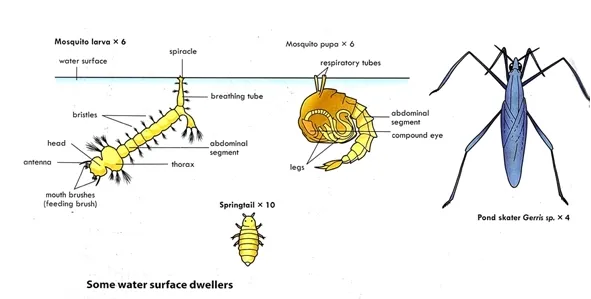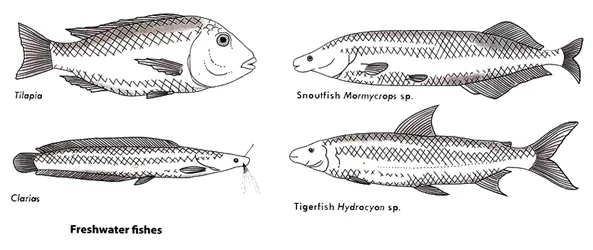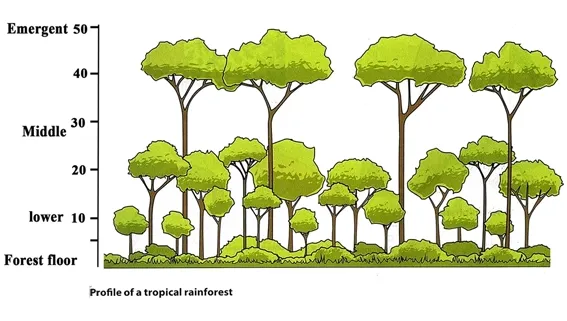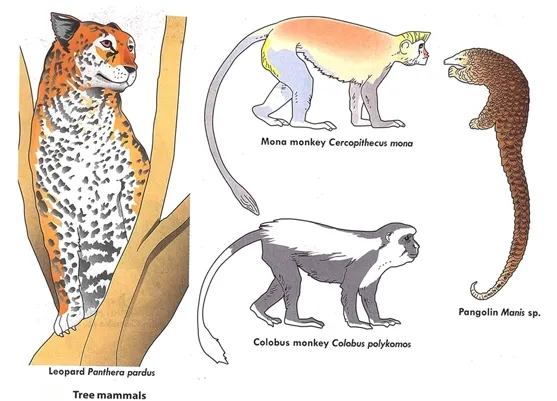Adaptations of organisms
Adaptation Definition
Adaptation: is the possession of structural and functional features which enable an organism to live successfully in its habitat.
Adaptations are characteristics that enhance the survival and reproduction of organisms in their specific environments. These adaptations can be structural, behavioral, or physiological, allowing organisms to thrive in diverse habitats, from deserts to oceans, forests, and polar regions.
Types of Adaptations
1. Structural Adaptations
Structural adaptations are physical features of an organism that enhance survival. Examples include:
- Camouflage: Enables organisms to blend into their surroundings (e.g., chameleons, leaf insects).
- Mimicry: Imitating the appearance of another organism for protection (e.g., monarch and viceroy butterflies).
- Body Structures:
- Arctic Fox: Thick fur for insulation in cold environments.
- Cactus: Spines instead of leaves to reduce water loss and deter herbivores.
- Aquatic Animals: Streamlined bodies to reduce resistance in water.
Behavioral adaptations involve actions or patterns of activity that improve survival. Examples include:
- Migration: Seasonal movement of animals to find better resources (e.g., birds migrating to warmer climates during winter).
- Hibernation: A state of dormancy to survive cold temperatures and food scarcity (e.g., bears).
- Nocturnal Activity: Avoiding predators and extreme heat by being active at night (e.g., owls, desert foxes).
These adaptations involve internal body processes and functions that enhance survival. Examples include:
- Temperature Regulation: Sweating in humans and panting in dogs to cool down.
- Water Conservation: Kangaroo rats produce highly concentrated urine to retain water in desert environments.
- Poison Production: Venom in snakes and toxins in frogs for defense or predation.
Importance of Adaptations
- Survival: Adaptations help organisms meet their basic needs such as food, shelter, and reproduction.
- Environmental Fitness: They allow organisms to be competitive in their niches.
- Evolution: Over time, adaptations lead to the evolution of species as they better fit their environments.
Examples of Organisms and Their Adaptations
Specific Habitats
o Aquatic Habitats- Marine ecosystems
- Freshwater ecosystems
- Tropical Rainforest
- Savanna
- Desert
- Arboreal habitat (on top of trees)
Aquatic Habitats
An aquatic ecosystem is an ecosystem in a body of water. The two main types of aquatic habitat are marine and freshwater.
Adaptations of Animals to Aquatic Habitat
· Possession of swim bladder for buoyancy
· Streamlined shape for easy movement
· Lateral line for detection of vibration
· Fin for movements
· Slimy body for easy movement
· Sucker for attachment onto vegetation
· Webbed limbs for swimming e.g. frog
Marine
They are distinguished from freshwater habitats by the presence of dissolved compounds, especially salts, in the water. They generate 32% of the world’s net primary production. Marine ecosystems are made up of seas, oceans, lagoons and estuarine.
Classes of organisms found in marine ecosystems include brown algae, dinoflagellates, corals, cephalopods, echinoderms, and sharks.
Estuaries or Brackish are coastal ecosystems where sea water and fresh water meet. The freshwater comes from rivers and streams and runs off from the land when it rains. The animals commonly found in estuaries include crab, mollusks, shrimps, bivalves.
Adaptations of Organisms to Marine Habitat
· Starfish use tube feet whiles mollusks use specialized foot for digging into the sand.
· Many crabs and annelids (worms) are active burrowers.
· Some animals avoid drying up by withdrawing into a protective shell.
· Algae (seaweeds) have holdfasts for attachment to rocks.
· Some algae have air filled bladders which enable the branches to float.
· Some seaweed has slime around the body which protects it from drying out.
· White mangrove has pneumatophores for gaseous exchange.
· Possession of waxy cuticles on the leaves to prevent wetting.
· Most aquatic plants have reduced conducting and strengthening tissues.
· Stomata are on the exposed surface of the leaves to increase the transpiration rate.
Freshwater
Freshwater ecosystems contain 41% of the world’s known fish species. Some organisms live on the surface of the water. Examples include microscopic algae such as diatoms, desmids, blue green bacteria and Chlamydomonas. These organisms form the Phytoplankton. Phytoplanktons are microscopic producers. Other free-floating organisms are spirogyra, water lettuce (Pistia) duckweeds (Lemma), salvania (aquatic ferns).
Microscopic free-floating animals or Zooplankton include crustaceans such as Cyclops, Daphnia and freshwater shrimps. Zooplanktons are the primary consumers of the ecosystem. They provide food for freshwater fish, e.g. Tilapia and tiger fish. Insects include water boatman, water beetle, pond skaters, mosquito larvae and pupae, and dragonfly larvae.
There are three basic types of freshwater habitats:
o Wetlands: areas where the soil is saturated or inundated for at least part of the time.
Adaptations of Plants to Freshwater Habitat
· Presence of waxy cuticle to repel water droplets.
· Leaves have large surface area for maximum water absorption.
· Plants that are submerged have thin cuticle permeable to water and mineral salts.
· Submerged plants have flexible stem to withstand the action of water currents.
· Leaves, roots or stems have large air space for floatation or buoyancy.
· Floating leaves have on its upper surface stomata for gaseous exchange.
· Some plants produce seeds that can float.
· some plants have leaves that float atop the water, exposing themselves to the sunlight
Examples: water lily, Elodea, Water lettuce, Lemma, duckweed.
Adaptations of Animals to Freshwater Habitat
o Streamlined shape for easy movement
o Lateral line for detection of vibration
o Possesses lomotory structures such as cilia, pseudopodia flagellates or fin for movement.
o Sucker for attachment onto vegetation
o Webbed feet for swimming.
{nextPage}
Terrestrial Habitats
Terrestrial habitats vary according to the type of vegetation. In the forest large trees are abundant; grasslands or savannah contain more grasses than trees and desert have little vegetation. The type of vegetation depends on the physical factors such rainfall, temperature and soil type. The distribution of organisms in different habitat depends partly on the vegetation and partly on climate factors.
Tropical Rainforest Habitat
The tropical rainforest is hot and it rains a lot, about 80 to 180 inches per year. Heavy rainfall increases the risk of flooding, soil erosion, and rapid leaching of nutrients from the soil. This abundance of water can cause problems such as promoting the growth of bacteria and fungi which could be harmful to plants. The distribution of organisms depends on the amount of sunlight that is made available to plant. Trees are the abundant plants. The rainforest is very thick, and much sunlight is not able to penetrate to the forest floor. The crown of rainforest trees forms three layers, storeys or canopies. Trees above 30m are called emergent. The middle layer is formed by trees about 30m high. The lower canopy, are trees about 15m high. Carpeting the forest floor is the palms, shrubs and herb layer made up of wildflowers, mosses, and ferns. Fallen leaves, twigs, and dried plants cover the ground, decompose, and help add nutrients to the topsoil.
The forest is rich with epiphytes and climbers. The epiphytes or aerophytes depend on trees for support only.
Examples of ground animals are tortoise, lizard, gaboon viper, mongoose, rat and mouse.
Adaptations of Plants to Tropical Rainforest
o green leaves use to trap sunlight for photosynthesis
o drip tips and waxy surfaces allow water to run off, to prevent bacteria and fungi growth
o buttresses, prop and stilt roots help hold up plants in the shallow soil
o climbers have hooks and tendrils to provide attachment and support
o flowers on the forest floor are designed to lure animal pollinators since there is relatively no wind on the forest floor to aid in pollination
o plants have shallow roots to help capture nutrients from the top level of soil
o epiphytic (orchids) have aerial roots that cling to the host plant and to absorb water
Adaptations of Animals to Tropical Rainforest
o Termites can climb, burrow and digest cellulose.
o The forest is the source of food and shelter to birds and other organisms.
o Insects such as ants or butterfly live in trees and build their shelter with plant leaves.
o Spiders construct webs among the branches of trees to trap insects
o Chameleons have narrow bodies and constant changing color, makes them inconspicuous amongst the foliage.
o Millipedes are mostly herbivores and have two pairs of legs for each body segment, enabling them to climb well.
o Frogs have sucker-like toes that make it possible to climb up trees.
{nextPage}
Savanna (Grassland) Habitat
A savanna is a rolling grassland scattered with shrubs and isolated trees, which can be found between a tropical rainforest and desert biome. Not enough rain falls on a savanna to support forests. There are actually two very different seasons in a savanna; a very long dry season and a very short wet season.
In West Africa there are three types of savanna zones; Guineasavanna, Sudan savanna and Sahel savanna. The change that occurs on passing from one zone into another is due to decreasing rainfall, increasing drought and annual burning of vegetation for farming purposes. Guinea savanna experience the highest rainfall followed by the Sudan and finally the Sahel zone.
Majority of savanna faunas (animals) are herbivores. Examples are mice, rat, zebra, antelopes, giraffe and elephants. Other organisms include ants, termites, pigeons, lizards and snakes.
Adaptations of Animals to Savanna Habitat
o Many burrow underground to avoid the heat or raise their young.
o Some migrate to deal with the lack of food during the dry season.
o Animals (e.g. giraffe and ostrich) are fast runners to escape predators
o They have well sense of smell which help them to detect their prey.
o Ruminants such as cattle and goat have stomachs that are adapted for storage of food for a long time.
Adaptations of Plants to Savanna Habitat
Vegetation must survive the long period of drought and the fires during the dry season.
o Grass grows quickly up to 130cm high during the short rainy season.
o Baobab tree has thick bark and store water in the trunks to withstand fire and drought
o Trees lose their leaves through the dry season to conserve moisture.
o Trees have few leaves so less moisture is lost through evaporation and transpiration
o Leaves are small, waxy and thorny to reduce moisture loss.
o Trees have long roots so as to extract water from the deep ground
Adaptations of Plants to Dry Terrestrial Habitat
· Have short life cycle to survive unfavorable conditions
· Succulent leaves or stem has water storage tissues
· Presence of thick waxy shiny cuticles or hairs on leaves to reduce water loss
· Sunken stomata or leaf rolling to reduce water loss
· Roots are deep seated for tapping water from soil
· Leaves are modified into spine or thorns for reduction of water loss or
The Desert Habitat
Desert organisms live in an environment that can be very harsh. Major problems include an average 10 to 12 hours hot sunshine a day, a scarcity of water and often of food, and predators. The soil is often sandy or rocky and unable to hold much water. Winds are often strong, and dry out plants. Plants are exposed to extreme temperatures and drought conditions. Animals respond to such conditions and have evolved mechanisms to deal with various extremes.
Adaptations of Plants to Desert Habitat
o Succulent plants store water in their stems or leaves
o Some plants have no leaves or small seasonal leaves that only grow in rain season, to reduce water loss. Leafless plants conduct photosynthesis in their green stems.
o Long root systems spread out wide or go deep into the ground to absorb water
o Plants have a short life cycle to survive unfavorable conditions
o Leaves with hair help shade the plant, reducing water loss.
o Some leaves turn throughout the day to expose a minimum surface area to the heat.
o Spines to discourage animals from eating plants for water
o Waxy coating on stems and leaves help reduce water loss.
Examples: Cacti, Euphorbias, xerophytes
Adaptations of Desert Animals
¨ They stay in the shade of plants or rocks or by burrowing underground.
¨ Many are nocturnal: they are active and hunt at night when it is cool.
¨ They do not have sweat glands and pass only small amounts of concentrated urine.
¨ Large ears help dissipate excess body heat on hot days
¨ Thick fur helps insulate the body from the cold desert nights.
¨ Thick skin helps to prevent drying out in the desert.
¨ A nictitating membrane on the eye wipe to remove sand from the eyes
¨ Enlarged appendages increase surface area which promotes heat loss.
Examples: kangaroos, rats, snakes, lizard, arachnids, a few birds and insects.
The Arboreal Habitat
Most animals live in trees and are termed as arboreal. These include grasshopper, butterfly, ants and spiders. Among reptiles are chameleons, gecko and snakes such green mamba. Common birds include African grey parrot, wood owls and several species of hornbills. Mammals include bats, monkeys (such as mona and colobus monkey), squirrels, pangolins and leopards.
Plants Adaptations to Arboreal Habitat
Ø Some plants are parasitic, extracting nutrients from the host plant e.g. mistletoe
Ø Epiphytes have aerial roots for absorbing moisture and nutrients from humid air
Ø Woody stems are very flexible to permit bending, twisting, and coiling.
Ø Epiphytic orchids have thick, waxy leaves for retaining water and allowing excess water to drip off.
Ø Climbers have hooks and tendrils to provide attachment and support.
Animals Adaptations to Arboreal Habitat
o Termites can climb, burrow and digest cellulose
o Insects such as ants and butterfly live in trees and build their shelter with plant leaves.
o Spiders construct webs among the branches of trees to trap insects.
o Chameleons have narrow bodies and constant changing color, makes them inconspicuous amongst the foliage.
o Moths can mimic insects that predators won't eat, such as wasps
o Frogs have sucker-like toes that make it possible to climb up trees.
o Birds have strong legs, with toes adapted for grasping.
o The long, curved claws of monkeys help them to cling on to branches, while their tails allow them to balance on narrow branches.
Get Your Free PDF!
Download our comprehensive guide to Population Ecology to boost your knowledge.
Download PDFClick the button above to get instant access to the PDF.
Download our comprehensive guide to Population Ecology to boost your knowledge.
Download PDFClick the button above to get instant access to the PDF.
Reference on Population Ecology:
- National Geographic: Population Ecology
- Khan Academy: Population Ecology
- BBC Bitesize: Population Ecology
- Encyclopedia Britannica: Population Ecology
- UCMP Berkeley: Population Ecology
- Nature: Population Ecology
- Nature Education Knowledge Project: Population Ecology
- What is population ecology
- Population Ecology | Learn Science at Scitable
- Population Ecology Definition, Model & Examples - Lesson
- Population ecology













.webp)


